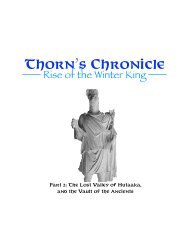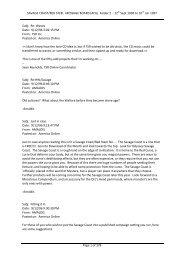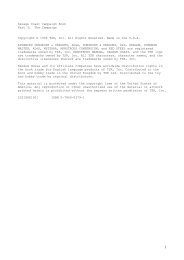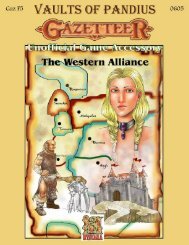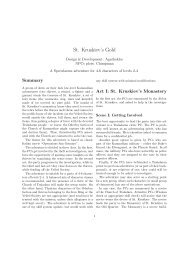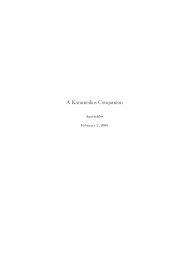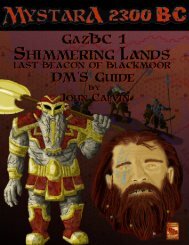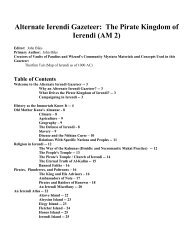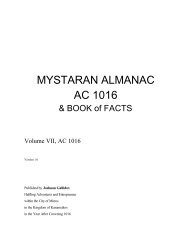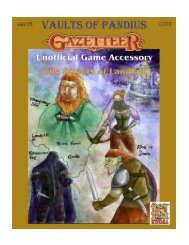Gaz F10 The Kingdom of Kaarjala - Vaults of Pandius
Gaz F10 The Kingdom of Kaarjala - Vaults of Pandius
Gaz F10 The Kingdom of Kaarjala - Vaults of Pandius
You also want an ePaper? Increase the reach of your titles
YUMPU automatically turns print PDFs into web optimized ePapers that Google loves.
GEOGRAPHY<strong>The</strong> Land<strong>Kaarjala</strong> is located north <strong>of</strong> the ArcticCircle, with much <strong>of</strong> its territory nestledin the Autuasmaa, a broad swampy riverplain between the Rivers Maanselkä(Landsplit) and Tukkijoki. <strong>The</strong> landslopes slightly from the northern spur <strong>of</strong>the Icereach Range in the west until itreaches the coast. A more distinct, flutedshape emerges along the north-southtransect, for the Autuasmaa sits slightlybelow both the Everwinter Lands and theViaskaland. West to east, the region hasan average height above sea level fallingfrom 600 feet to 200 feet.<strong>The</strong> Autuasmaa is still undergoingextensive post-glacial rebound, with acurrent average rise <strong>of</strong> two inches percentury around Kaarja and points west,and one inch per century at the coast.This process will accelerate in the nextfew centuries, and it is plausible that thecoastline will extend an additional four toeight miles after another 800 years.<strong>Kaarjala</strong>’s most abundant naturalresources are iron, peat, and wood; otherresource needs are generally met throughtrade with Littonia.Mountains and HillsAlthough <strong>Kaarjala</strong> is not significantlyelevated above sea level, there are anumber <strong>of</strong> hills and mountain ranges inthe wider region that merit description.<strong>The</strong> Raatovaarat Mountains areactually a line <strong>of</strong> steep hills rangingbetween 500 and 800 feet above the localbaseline. <strong>The</strong>y run southwest from LakeHämäräjärvi beyond <strong>Kaarjala</strong>’s westernborders. <strong>The</strong> mountains are comprisedprimarily <strong>of</strong> sandstone that was foldedand uplifted millions <strong>of</strong> years ago, andthen subsequently battered by theelements. <strong>The</strong> recent glaciation period cutseveral steep valleys through them, whichwere then enlarged by explosivewatershed events and tremors followingthe destruction <strong>of</strong> the Alphatian <strong>Kingdom</strong><strong>of</strong> Alinor.Although much <strong>of</strong> the resulting waterflows made their way to Hämäräjärvi, aconsiderable quantity was redirectedunderground, where they carved outnumerous caverns. Many <strong>of</strong> these caveshave since dried, but they have not beenextensively explored. Persistent rumorsstate that deposits <strong>of</strong> silver are abundantin the caverns’ lower levels, but that themetal recoils from the touch <strong>of</strong> men.Mercury hazards abound around lodes <strong>of</strong>silver and titanium.Also significant are the PallastunturiHills, which constitute the northernfoothills <strong>of</strong> the Icereach Range. <strong>The</strong>yrange in height from 150 feet above thebaseline at their northernmost extent, tomore than 1,000 feet where they meet themountains proper. This region isexceedingly bleak, being fully exposed tothe prevailing arctic climate.<strong>The</strong> closest true mountains are theRaanivaara Mounts, or Winter Peaks,an isolated segment <strong>of</strong> the Icereach thatwas cut <strong>of</strong>f by random aftershocks <strong>of</strong> theearthquake that destroyed Alinor. <strong>The</strong>Peaks average 12,000 feet in height, andare igneous (granite) like much <strong>of</strong> theIcereach. Over the years a handful <strong>of</strong><strong>Kaarjala</strong>ns and others have visited themountains in search <strong>of</strong> precious metalsand other deposits, but those whoreturned did so empty-handed. <strong>The</strong> lessfortunate ran afoul <strong>of</strong> the localhumanoids that dwelled in a series <strong>of</strong>caves within the eastern foothills.Immediately south <strong>of</strong> the Winter Peaksare the Karelides, another semi-isolatedcluster <strong>of</strong> mountains within the Icereachsystem. All that is presently known <strong>of</strong>this large massif has come courtesy <strong>of</strong>adventurers and explorers. <strong>The</strong>re are twoprimary ridgelines that run north-south inthe Karelides, but much <strong>of</strong> the rest seemsunstructured. <strong>The</strong> dominant peak in thisgroup is the ice-covered peak <strong>of</strong> Halti(19,800 feet). <strong>The</strong> local granite containsuntapped veins <strong>of</strong> silver and iron.ForestRoughly half <strong>of</strong> <strong>Kaarjala</strong>’s territory iscovered by coniferous forests – primarilywhite pine and spruce – and a few stands<strong>of</strong> birch. <strong>The</strong> thin, acidic soil <strong>of</strong> theregion – mostly moraine or glacial tillcovered with a very thin layer <strong>of</strong> humus –prevent all but the hardiest undergrowthfrom growing. <strong>The</strong> most common shrubsand bushes are juniper, cranberry, anddwarf willow. Where there is no soil, theregion’s granite bedrock is clearlyvisible.Beyond the warming effects <strong>of</strong> theGreat Sampo, the prevailing arcticclimate descends with a vengeance, andthe only vegetation that manages tosurvive are varieties <strong>of</strong> lichens, mosses,sedge grasses, and low-lying floweringplants adapted to the arctic, such as arcticpoppies, purple saxifrage, and whitlowgrass. <strong>The</strong>se are fairly widespread southand east <strong>of</strong> <strong>Kaarjala</strong>, but vegetation thinsout dramatically within forty miles <strong>of</strong><strong>Kaarjala</strong>’s northern and western frontiers.This is especially true for the windsweptPallastunturi Hills, which are utterlydevoid <strong>of</strong> any vegetation, and thedesolate tundra <strong>of</strong> the Everwinter Lands.<strong>The</strong> Plains<strong>The</strong> central portion <strong>of</strong> <strong>Kaarjala</strong> isdominated by the Autuasmaa (Land <strong>of</strong>Bliss) Plain, a region that once lay at thebottom <strong>of</strong> a great glacial lake. Centuries<strong>of</strong> sedimentation have given the plainsome <strong>of</strong> the richest soils in the far north,but the land would still be consideredmarginal by Known World standards.Tall grasses are the major vegetationwhere the land is not being tilled, withfrequent patches <strong>of</strong> natural wildflowers.Southwest <strong>of</strong> <strong>Kaarjala</strong> lies the Plain <strong>of</strong>Skulls, so named because much <strong>of</strong> thefighting during the Battle <strong>of</strong> the Skullswas conducted here, leaving the bodies <strong>of</strong>untold numbers <strong>of</strong> humans andhumanoids intermixed with the skeletalremains dating to the Great Rain <strong>of</strong> Fire.This region was bleak to begin with; theaddition <strong>of</strong> the skeletal remains <strong>of</strong> morethan 10,000 humans, giants, andhumanoids made it more so. Few peopleventure here willingly; even the localhumanoid tribes give it a wide berth.WaterwaysTowards the end <strong>of</strong> the last ice age –when the destruction <strong>of</strong> Alinor shatteredthe northern ice shield – retreatingglaciers produced a great lake thatdominated what is now central <strong>Kaarjala</strong>from Lakes Isojärvi and Pohjanjärvi tothe confluence <strong>of</strong> the Kesäjoki River.Lake Hämäräjärvi was roughly doubleits current size, with a marshy peninsulacutting the lake in half where the modernnorthern lakeshore rests.10



